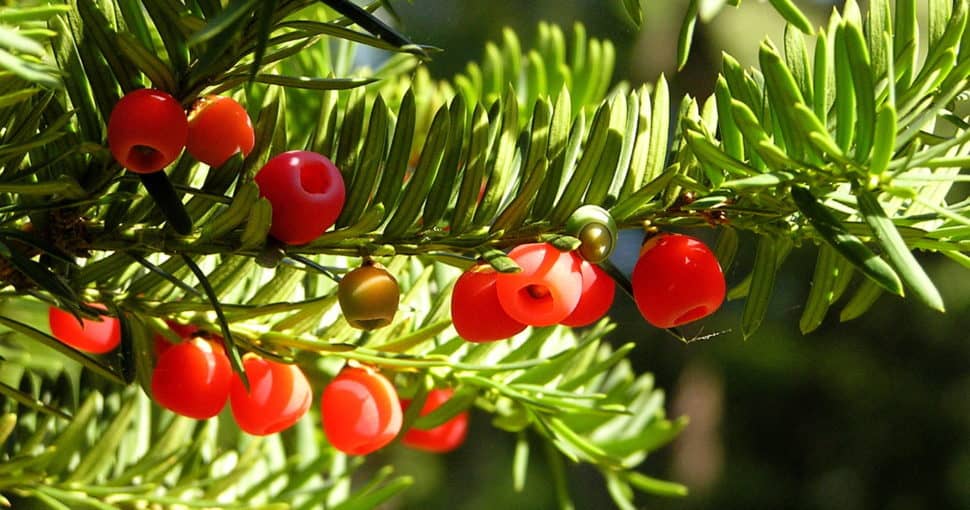The yew tree (Taxus baccata) is popular in gardens as it is evergreen and produces attractive bright red berries. It occurs naturally in various climates throughout Britain, Europe, Northern Africa, Iran, and Southwest Asia. An adaptable tree like this is easy to grow, and many gardeners may be tempted to plant it. There is quite a lot of contradictory information about the toxicity of yew berries. It is critical to know if yew berries are poisonous.
Contents
Yew berries are red berries that surround a seed. The red flesh of the berry is not poisonous, but the seed is highly toxic. The poison from yew berry seeds can be absorbed through the skin or ingested when the berry is eaten. Yew berries are poisonous to people, dogs, cats, and livestock.
Some people that observe birds and some wild animals eating yew berries may consider yew berries safe to eat. It is essential to know the details about the toxicity of these berries as mistakes can be deadly.
What Poisons Are Found In Yew Berries?
Yew berries have a pip surrounded by a red gelatinous round ‘fruit.’ The red part of the berry is known as the aril. The aril may look like a fruit, but it is, in fact, an adapted cone scale and is often called a false fruit.
Yew arils are sweet and non-poisonous with no specific flavor. The seed housed within the berry is highly toxic and bitter.
Yews are trees that took self-protection to the extreme. They contain
- at least ten alkaloids
- cyanogenic glycoside esters known as nitriles
- ephedrine
- essential oils
The most poisonous of the yew alkaloids are taxine alkaloids. These toxins affect the calcium and sodium channels responsible for nerve impulse conduction and muscle contraction.
As a result of the disruption of the channels, the heart muscles cannot contract, and the conduction of cardiac electrical impulses is disrupted. This causes catastrophic arrhythmias, which lead to cardiac arrest or severely damage the heart.
The poisons occur in all parts of the yew tree, including the seeds. Only the arils are free of toxins. The European and Japanese yew are considered the most toxic of all the yew species. The highest concentration of yew toxins is found in the seed.
Are Yew Berries Poisonous To People?
Humans may eat the aril covering the seed without any ill effect. Care must be taken to avoid accidentally cracking or biting the seed as released toxins may be absorbed through the oral membranes.
If the seeds or any other part of the yew tree, except the aril, are ingested, the person will show symptoms of poisoning. Children are particularly vulnerable to taxine alkaloids. Unfortunately, small children are drawn to the bright red berries and eat them, ingesting the seed along with the red aril.
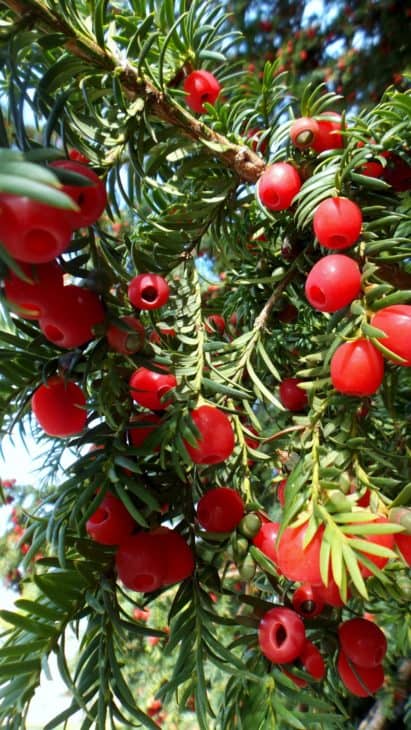
Symptoms of yew poisoning are:
- Nausea and vomiting
- Abdominal pain with possible diarrhea
- Dizziness
- Confusion and anxiety
- Chest pain
- Irregular heart rate
- Respiratory distress
- Low blood pressure
- Loss of consciousness
- Seizures
- Cardiogenic shock
- Death
The average time of death from the ingestion of yew berries is two to five hours. The cardiac effects of taxine alkaloids can be so severe that it is difficult for medical staff to save the poisoned individual.
Some people are allergic to yew trees, and this includes the berries. Life-threatening anaphylaxis could result from contact with yew berries.
Eating yew berries seems like a huge risk to take for a morsel that, although sweet, is not particularly tasty.
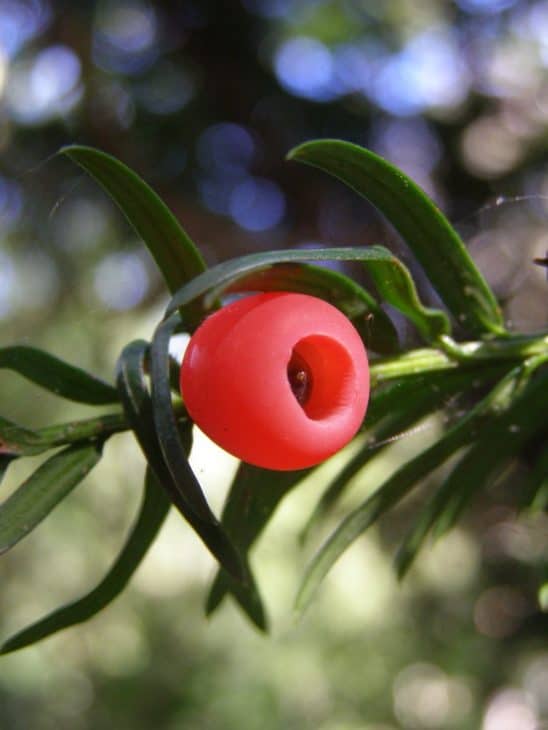
Are Yew Berries Toxic To Dogs And Cats?
Yew berries are toxic to both dogs and cats as they will ingest the whole berry, including the seed. The symptoms will be similar to humans. Poisoning from yew berries in dogs and cats will present with the following symptoms:
- Salivation and drooling
- Nausea and vomiting
- Dilated pupils
- Breathing difficulties
- Irregular heart rate
- Low blood pressure
- Tremors
- Seizures
- Loss of consciousness
- Death due to cardiac failure
Are Yew Berries Toxic To Horses And Other Livestock?
Horses and other livestock usually come into contact with yew berries when they drop from trees onto the grass, or yew branches used as decoration are thrown out after Christmas. The berries are toxic in their fresh and dried form.
Livestock are particularly susceptible to poisoning by any part of the yew tree, including the berries. Generally, there is little time to observe symptoms from yew poisoning in livestock. The most common picture is to find the animal lying dead in the field where it consumed the yew.
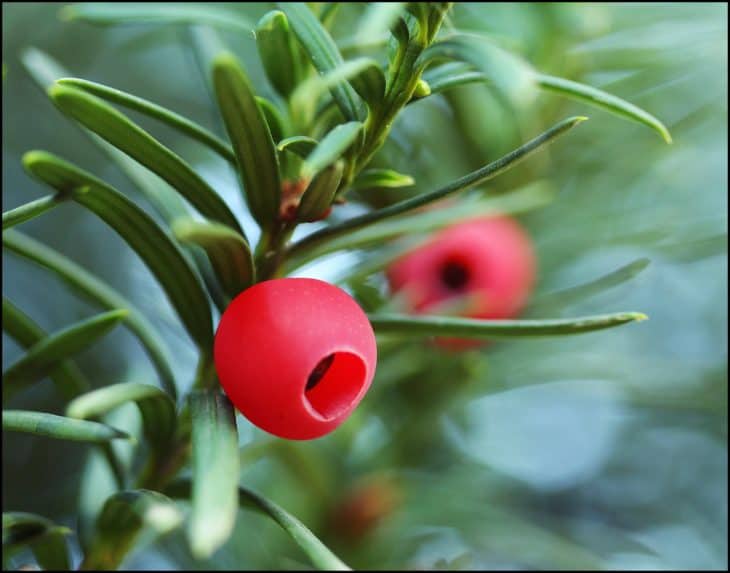
Horses seem to be particularly sensitive to taxine alkaloids. There have been accounts of horses found dead with yew leaves or berries still in their mouths.
If the farmer pays close attention and notices the poisoning, the following symptoms will be seen:
- Swelling of the head, lips, tongue, and eyes.
- Incoordination
- Profound weakness where the animal cannot stand, walk, or even raise its head.
- Nervousness
- Diarrhea
- Slow irregular heartbeat.
- Tremors and muscle twitching
- Seizures
- Death
It is critical that livestock, including horses, never have any access to yew berries or any part of a yew tree.
Are Yew Berries Toxic To Birds?
Yew berries are red and sweet and therefore attract fruit-eating birds. These birds are adapted to passing the berries through their digestive system without suffering any harm. Fruit-eating birds pass the whole seeds in their droppings and, in this way, assist the plant with seed dispersal.
Yew berries are highly toxic to non-fruit-eating birds, and they will die if they consume them. Do not give yew berries to any pet birds.
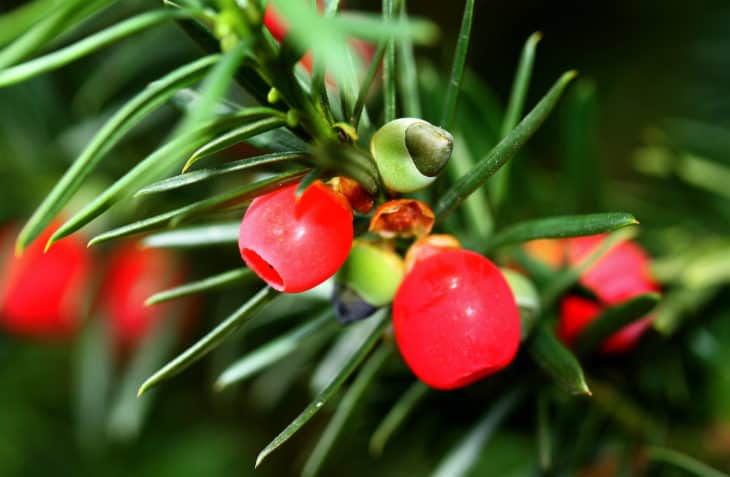
Are There Animals That Can Safely Eat Yew Berries?
Badgers, deer, moose, elk, and squirrels can all eat yew berries without apparent harm from the toxins.
Scientists are unclear on the exact mechanisms that protect these animals from the toxins. One theory is that the berries pass through these animals’ digestive systems fairly rapidly. The yew seed coating is undisturbed, and the harmful toxins remain enclosed in the seed.
Much more research is needed into the toxic effects of yew berries on wildlife. In 2008 a study was published that showed a moose had died from yew poisoning. Researchers were puzzled by this as it contradicted previous observations.
Conclusion
Yew berries contain toxic seeds, but the red aril surrounding the seed is not harmful. Toxins contained in yew trees are lethal and difficult to counteract medically. Extreme caution should be used when yew trees are present. It is best to avoid having yew trees in your garden.

